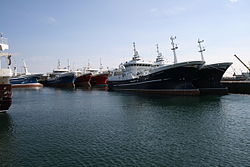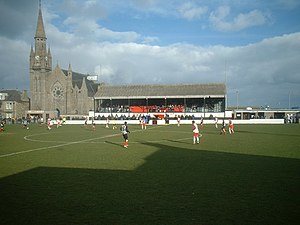Fraserburgh
| Fraserburgh Scots: The Broch | |
| Aberdeenshire | |
|---|---|
 Fishing Boats in Fraserburgh Harbour | |
| Location | |
| Grid reference: | NJ997670 |
| Location: | 57°41’35"N, 2°0’18"W |
| Data | |
| Population: | 12,630 |
| Post town: | Fraserburgh |
| Postcode: | AB43 |
| Dialling code: | 01346 |
| Local Government | |
| Council: | Aberdeenshire |
| Parliamentary constituency: |
Banff and Buchan |
Fraserburgh is a town and parish in Aberdeenshire with a population recorded in the 2001 Census at 12,454[1] and estimated at 12,630 in 2006. It lies at the extreme north-east corner of Aberdeenshire, around 40 miles north of Aberdeen, and 17 miles north of Peterhead. It is the largest shellfish port in Europe, landing over 12,000 tonnes in 2008,[2] and is also a major white fish port and busy commercial harbour.
History
The name of the town means, literally, 'burgh of Fraser', after the Frasers of Philorth who bought the lands of Philorth in 1504 and thereafter brought about major improvement due to investment over the next century. Fraserburgh became a burgh of barony in 1546. By 1570, the Fraser family had built a castle (Fraserburgh Castle) at Kinnaird's Head and within a year the area church was built. By the 1590s the area known as Faithlie was developing a small harbour.
In 1592, Faithlie was renamed Fraserburgh by a charter of the Crown under King James VI. Sir Alexander Fraser was given permission to improve and govern the town as Lord Saltoun. At present this title is still in existence and is held by Flora Fraser, 20th Lady Saltoun and head of Clan Fraser. The Royal Charter also gave permission to build a college and university in Fraserburgh allowing the Lord Saltoun to appoint a rector, a principal, a sub-principal, and all the professors for teaching the different sciences.
A grant from the Scottish Parliament in 1595 allowed the first college building to be erected by Alexander Fraser, and in 1597 the General Assembly of the Church of Scotland recommended the Rev Charles Ferme, then minister at the Old Parish, to be its first (and only) principal.[3]
In 1601, Fraserburgh became a burgh of regality. The college, however, closed only a decade or so after Ferme's arrest on the orders of James VI for taking part in the 1605 General Assembly, being used again only for a short time in 1647 when King's College, Aberdeen temporarily relocated owing to an outbreak of plague. A plaque commemorating its existence may be seen on the exterior wall of the remains of the Alexandra Hotel in College Bounds.
Fraserburgh thereafter remained relatively quiet until 1787 when Fraserburgh Castle was converted to Kinnaird Head Lighthouse, Scotland's first mainland lighthouse. In 1803, the original 1571 church building was replaced and enlarged to seat 1000 people. The Auld Kirk was to be the standing authority in the town up until the 1840s.
The Statistical Account on the Parish of Fraserburgh, written between 1791-1799 (probably 1791) by Rev. Alexander Simpson of the Old Parish Church, shows that the population of Fraserburgh was growing with peaks due to seasonal employment. He records a population of about 2000 in 1780 of whom only 1000 resided in the town. There was an additional population of 200 in the village of Broadsea. He makes a point of the arrival of Dr. Webster in Fraserburgh in 1755 claiming that the population then only stood at 1682. By the time the account was written the population had increased by 518 souls since 1755. Rev. Simpson also gives accounts of deaths, births and marriages. Between 1784-1791, he claims to have an average of 37 baptisms, 14 marriages and 19 deaths per year. More notably, the statistical account mentions activities with the harbour. He describes the harbour as small but good, telling that it had the capability to take vessels with '200 tons burden' at the time the account was written. The account also mentions that Fraserburgh had tried and succeeded in shipbuilding especially after 1784. His account finishes speaking of a proposed enlargement of the harbour. He claims that the local people would willingly donate what they could afford but only if additional funding was provided by the Government and Royal Burghs.
The second statistical account, written as a follow up to the first of the 1790s, was written in January 1840 by Rev. John Cumming. He records population in 1791 as 2215 growing to only 2271 by 1811, but increasing massively to 2954 by 1831. He considered the herring fishing, which intensified in 1815, to be the most important reason for this population boom. By 1840 he writes that seamen were marrying early with 86 marriages and 60 births in the parish in the space of one year. On top of this increased population, he explains that the herring season seen an additional 1200 people working in the Parish. There is also mention of the prosperity of this trade bringing about an increase in general wealth with a change in both dress and diet. Cumming also records 37 illegitimate children from 1837-1840 although he keeps no record of death. The prosperity of the economy also brought about improvement within the town with a considerable amount of new houses being built in the town. The people were gaining from the herring industry as in real terms rent fell by 6% from 1815 to 1840. Lord Saltoun was described as the predominant land owner earning £2266,13s,4d in rents. This period also saw the extension of the harbour with a northern pier of 300 yards built between 1807-1812 and, in 1818, a southern pier built by Act of Parliament. Cumming states that no less than £30,000 was spent developing the harbour between 1807 and 1840 by which time the harbour held 8 vessels of 45-155 tons and 220 boats of the herring fishery.
A railway station opened in 1865 and trains operated to Aberdeen via Maud and Dyce, as well as a short branch line to St Combs. It was, however, closed to passengers in 1965 as part of the Beeching cuts, though freight trains continued to operate until 1979, after which the station site was redeveloped.
Landmarks
The town has several attractions including an award winning sand beach,[4] a major harbour, the lighthouse museum, heritage centre and a variety of amenities and facilities. It is home to the famous Kinnaird Head lighthouse/castle.
Churches
The oldest church building in Fraserburgh is Fraserburgh Old Parish Church. Fraserburgh has though a variety of churches including:
- Church of Scotland:
- Old Parish,
- South Church
- West Church
- Pentecostal churches:
- Elim Pentecostal
- Assembly of God
- Calvary Church
- Emmanual Christian Fellowship
- Other:
- Bethesda Evangelical Church
- Brethren
- Congregational
- Episcopal
- Roman Catholic
- The Salvation Army.
Photo gallery
-
The Wine Tower
-
Kinnaird Head
-
Harbour Lighthouse
-
The 'White Horse' on Mormond Hill.
-
Cairness House near Fraserburgh
-
Park near Fraserburgh
-
Kinnaird Head and the ancient Wine Tower
Education
The town has a variety of educational establishments, including four primary schools (Fraserburgh North School, Fraserburgh South Park School, Lochpots School, St Andrew's School), a secondary school (Fraserburgh Academy), a SEN school (Westfield School), and a college of further education (Banff and Buchan College).
For the short-lived Fraserburgh University see above under History.
The Fraserburgh Academy was opened in 1909 in an older, building which now houses the school's Art Department. A new, more modern school was built in the 1950s, and improvements are constantly being made.
Economy
Fraserburgh is heavily dependent on the fishing industry, which provides 60% of employment in the town.[5]
BrewDog, Scotland's largest independent brewery, is based in the town.[6]
Sports

Fraserburgh has a number of sporting facilities including a swimming pool, ten-pin bowling alley, tennis courts, putting green, martial arts dojo, skatepark and football pitches.
Fraserburgh golf club is the fifth oldest club in Scotland and seventh oldest in the world. It has both an 18 hole and a 9 hole course, and a modern clubhouse.
Fraserburgh Football Club is a senior football club that plays in the Highland Football League. Fraserburgh United FC is a junior football club that plays in the Scottish Junior Football North Premier League (also known as the North Superleague).
Local dialect
The town has a strong version of the Doric dialect of Scots. As a result, a recent documentary series from the BBC entitled 'Trawlermen' was subtitled to ensure viewers outwith the local vicinity could follow the programme in full. A typical greeting is "Fit like?" meaning "How are you?".[7]
Notable people
- George Bruce (1909-2002): Poet of the Scottish literary renaissance[8]
- Charlie Duncan (football manager): Fraserburgh Football Club manager from 1984.
- Bill Gibb (1943-1988): born in Fraserburgh; became international fashion designer[9][10]
- Steve Fairnie (1951-1993) : Fraserburgh born musician, painter, sculptor, actor, board game designer, chicken hypnotist, frontman of the post-punk band Writz and half of the Techno Twins.
- William Fraser, 12th Lord Saltoun (1654-1715): born in Philorth; voted against ratifying the Treaty of Union.
- Thomas Blake Glover (1838–1911): born in Fraserburgh, where his father worked for the coastguard, moved to Japan and founded Mitsubishi Company. Known as the Scottish Samuri. He has a local chip shop named after him.
- Charles Alfred Jarvis Recipient of the Victoria Cross. He was the first person to be awarded a VC during the First World War.
- Robertson Macaulay (1833-1915): one time president of Sun Life Assurance Company of Canada).
- Charles Rawden Maclean (1815–1880), alias "John Ross" opponent of slavery, was born in Fraserburgh[11]
- James Ramsay (1733–89): born in Fraserburgh; anti-slavery campaigner.
- Sir George Strahan (1838–87): born in Fraserburgh; British colonial governor.
- Christian Watt (1833-1923): author of 'Christian Watt diaries'
- Joseph Watt (1887-1955): Gardenstown born; recipient of the Victoria Cross 15 May, 1917[12]
- Stan Williams (1940-): Liverpool born but lived in Fraserburgh since 1975; author of 'Penny Lane is in My Ears and in My Eyes' about growing up with The Beatles[13]
Outside links
- Fraserburgh: Scotland's leading light
- Fraserburgh Heritage Centre
- Banff and Buchan College
- Macrae Foods Ltd.
- Cairness House
- Buchan hillwalking club
- Historian's pages on the fishing villages of the North East
- Fraserburgh Leisure Centre — featuring local cuisine, bar, and family entertainment
- Museum of Scottish lighthouses — the first lighthouse built on mainland Scotland
- Alexander Carrick, sculptor of war memorial
References
- ↑ Comparative Population Profile:Fraserburgh Locality Scotland scrol.gov.uk, accessed 31 October 2008
- ↑ Fishing Industry Statistics, Aberdeenshire Council (November 2009)
- ↑ (ed.) Thomson, Thomas, Acts and Proceedings of the General Assemblies of the Kirk of Scotland, Church of Scotland General Assembly, Edinburgh, 1845.
- ↑ Beaches aberdeenshire.gov.uk, accessed 3 November 2008
- ↑ There is no Christmas cheer in Peterhead' guardian.co.uk, 22 December 2002
- ↑ http://www.bbc.co.uk/lastmillionaire/entrepreneurs/jamesw.shtml
- ↑ Trawlermen land haul of support BBC News, August 8, 2006
- ↑ George Bruce Poet of the Scottish literary renaissance independent.co.uk, 29 July 2002
- ↑ Bill Gibb - Fashion fraserburghheritage.com, accessed 31 October 2008
- ↑ Back in vogue - Bill Gibb scotsman.com, 15 October 2008
- ↑ "John Ross Memorial". Fraserburgh Heritage Centre. http://www.fraserburghheritage.com/default.asp?page=48. Retrieved 19 June 2010.
- ↑ Joseph Watt findagrave.com, accessed 31 October 2008
- ↑ Another side of a working class hero liverpooldailypost.co.uk, 18 March, 2008






